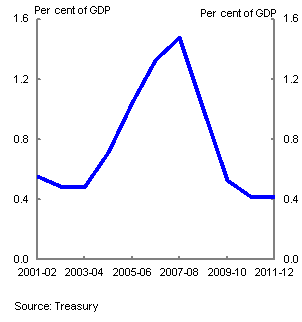Structural budget balance estimates are produced by adjusting the budget balance for influences that are considered to be temporary. These adjustments should have regard for, and differ depending on, the economic structure, tax system and fiscal settings of individual countries (IMF, 2011). For example, in addition to adjusting for the economic cycle (automatic stabilisers), the IMF adjusts Chile’s and Peru’s budget balances for commodity price developments, while Hong Kong’s budget balance is adjusted for land revenues and investment income (IMF, 2013). This section outlines adjustments most relevant in the Australian context and concludes that adjustments for the economic cycle, the terms of trade and CGT collections are most appropriate.
A key element of the Australian Government's medium-term fiscal strategy is that the budget balance should be allowed to vary in the short term with economic conditions, accommodating the operation of automatic stabilisers. During an upswing in the economic cycle, tax receipts will rise automatically with income and assist in containing inflationary pressures. On the expenditure side, unemployment-related benefit payments tend to fall during upswings in activity, again helping to moderate aggregate demand and inflationary pressures. The converse occurs when the economy moves below its productive potential. With around 70 per cent of Commonwealth Government tax receipts attributable to personal income and corporate taxes (which are sensitive to economic conditions), and unemployment benefits roughly 2 per cent of government expenditures, adjusting for the impact of the economic cycle on the budget balance is therefore relevant when considering the structural position of the budget.
As a major commodity exporter, another relevant consideration is the impact of the terms of trade on the Commonwealth Government’s budget balance. Australia has experienced a very large surge in the terms of trade over the past decade, even compared with other commodity exporting countries (Chart 1). The terms of trade directly affects the Commonwealth Government budget through the influences of commodity prices on company and resource rent tax receipts.3 In the decade to 2010-11, the proportion of total income tax paid by mining companies rose from around 3 per cent to 7 per cent, while resource rent taxes grew to be roughly 0.3 per cent of Government’s tax receipts.
Lastly, the Australian Government’s CGT receipts are strongly pro-cyclical, driven primarily by house and equity prices. CGT receipts peaked at around 1½ per cent of GDP prior to the global financial crisis (GFC) (Chart 2). The decline in global equity prices during the GFC and the associated capital losses, coupled with weak asset price growth since, has reduced CGT receipts to less than ½ per cent of GDP, a fall of around 70 per cent from the peak in 2007-08.
Other factors can also have a large temporary influence on the Australian Government’s budget balance, including natural disaster relief and temporary policy measures, such as the fiscal stimulus put in place by the Australian Government during the GFC. The structural budget balance estimates in Part 4 do not adjust the budget balance for these other temporary factors, instead focusing on economic drivers. This is consistent with the approach taken by the IMF and OECD in deriving their estimates of the structural budget balance for Australia. However, sensitivity analysis in Part 5 shows the impact on the structural budget balance estimates of adjusting for the Government’s fiscal stimulus measures, as shown in the 2009-10 Budget and by McDonald et al (2010).
Chart 1: Terms of trade comparison

Chart 2: CGT receipts share of GDP

3 Indirect effects on the Government budget from the terms of trade may also be significant, because companies that supply goods and services to the mining industry also benefit from stronger earnings, while other companies (and employees) gain indirectly as incomes flow through to other parts of the economy (see Budget Statements 2 and 5 2008-09).